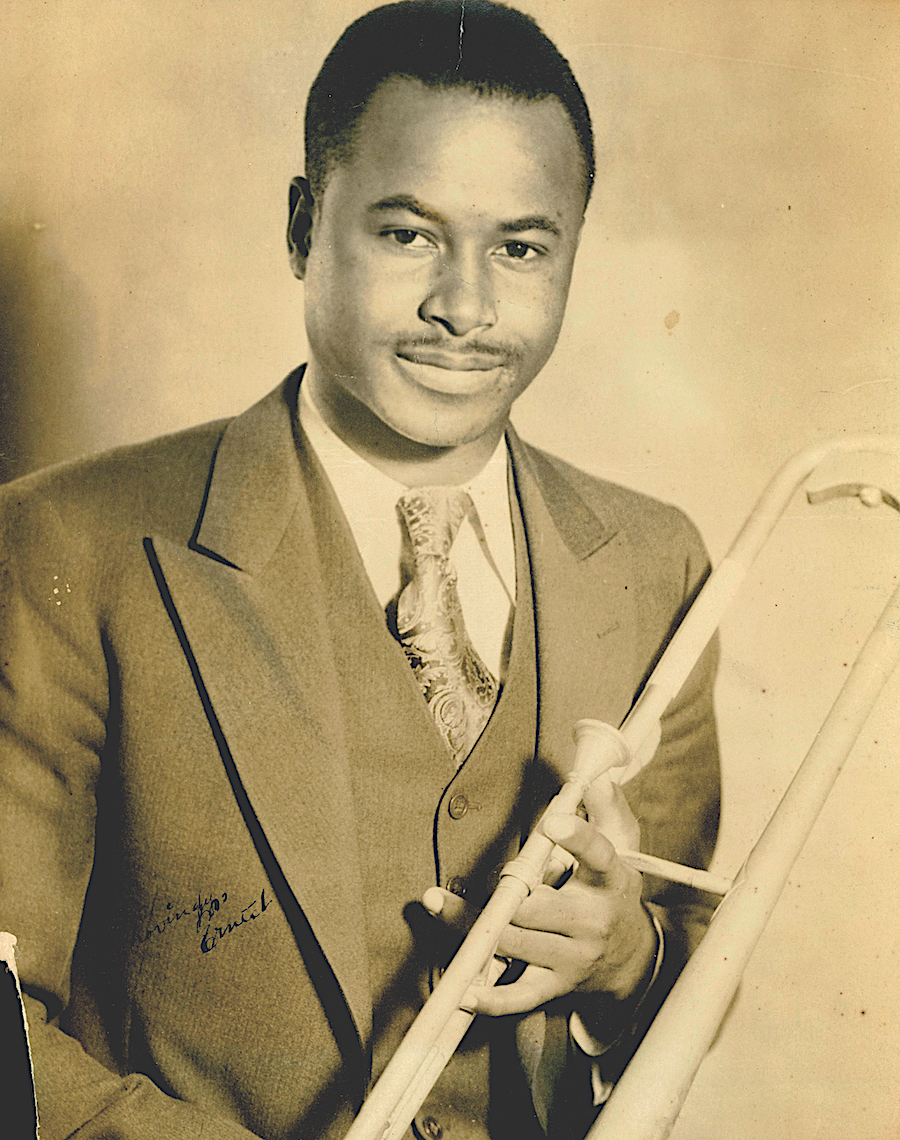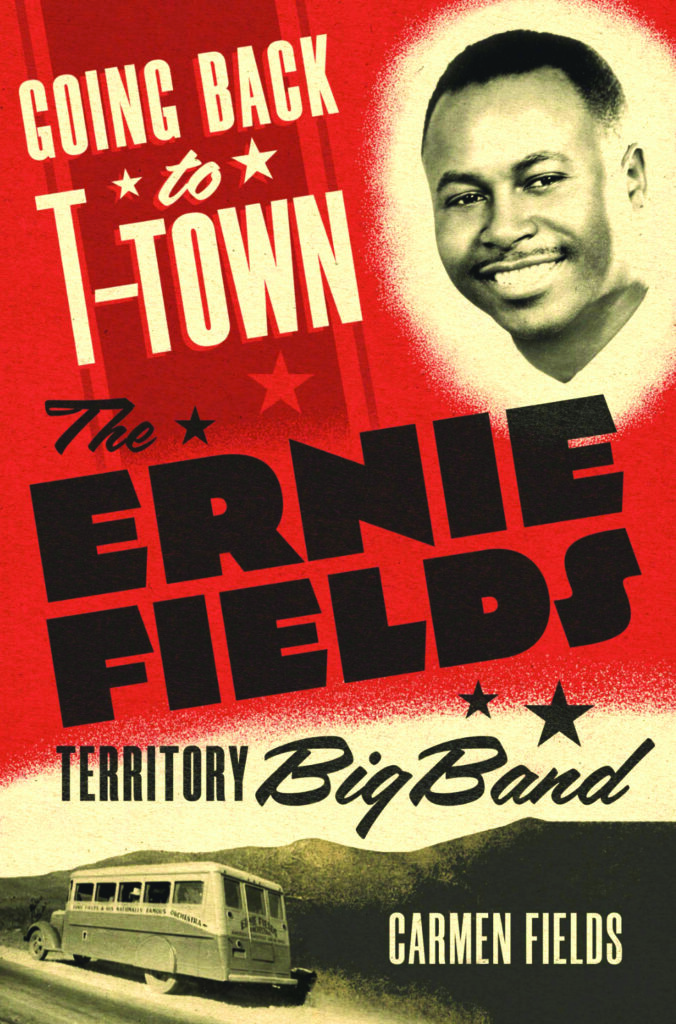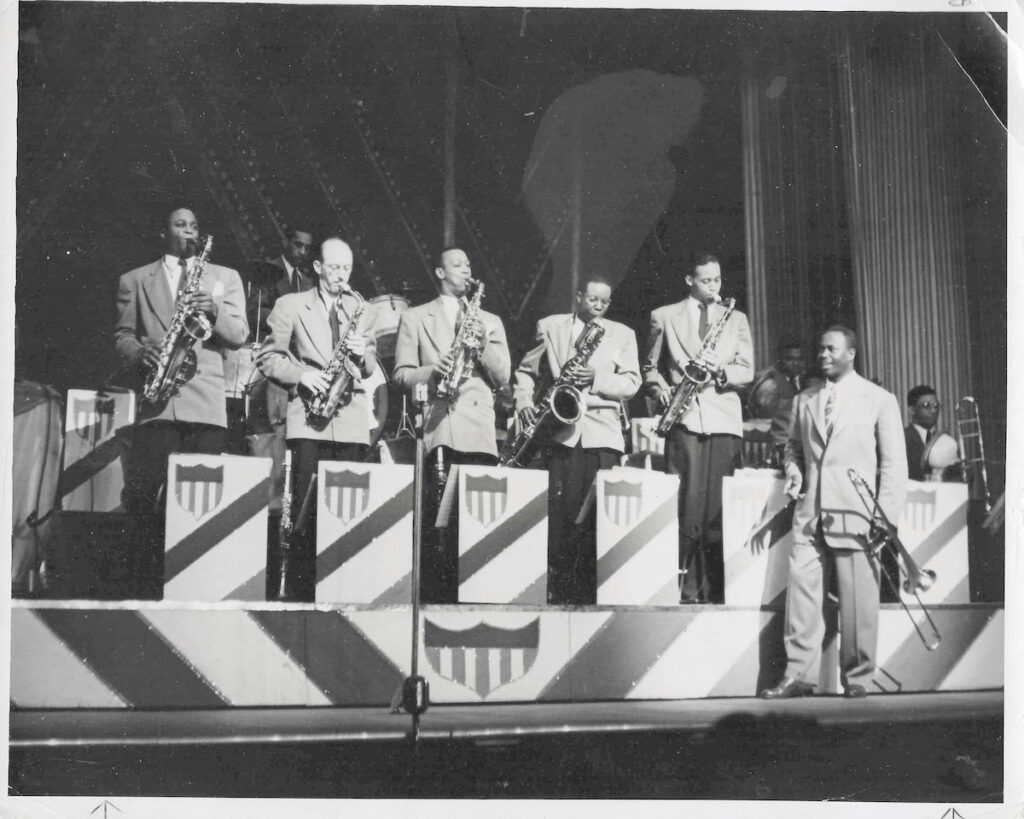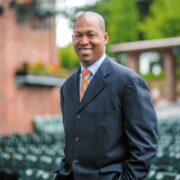
The singer Melvin Moore did the vocals. Trumpeter Amos Woodruff performed a soulful solo. The top song on the album was “Going Back to T-Town,” by Oklahoma musician Jimmy Webb.
But the show’s star was the 35-year-old African American band leader, Ernie Fields. By that time, the Oklahoman and his orchestra were no strangers to the jazz public. But that nine-song album was one of the first huge breaks for Fields and his band. As much as any event, the LP, called “T-Town Blues,” helped put Fields and his group on the national map.
Over the years, Fields’ bands — first the Royal Entertainers and later the Ernie Fields Orchestra – would earn vital spots in the annals of jazz music. As one of the “territory bands” prominent in the early to mid-1900s, the Royal Entertainers mainly played in clubs in the Midwest, centering around Kansas City. But from the late 1920s to the mid-1960s, the band gained profile with Fields at the helm, and performed in clubs from the New Club Alabam in Los Angeles to the Apollo in New York City and many a ballroom and club in between. Fields’ version of the jazz favorite “In the Mood” rose to No. 4 on the Billboard chart in 1959. Besides band leader, Fields was an accomplished trombonist and pianist.
A figure in jazz history
While Fields’ recordings and performances created an impressive legacy, the just-released “Going Back to T-Town,” a lively anecdote-rich book about the musician and band leader by his daughter, renowned Tulsa-born journalist Carmen Fields, cements his place in national jazz history.
Fields was a prolific storyteller, and his recounting of the antics of the music world and his engagements in it provided his daughter with much of the material for the book. A captivating yarn of the intriguing tales from Fields’ life, the book serves as a keepsake for Fields’ loyal fans and a refresher of his achievements for a younger generation of readers.
It tells how famed talent scout John Hammond, who had discovered Count Basie, among others, pushed Fields to set out from Tulsa for New York in the late 1930s pursuing national fame; of how Fields employed a young Miles Davis for a few gigs in Illinois; and how he enhanced his band stage act with side shows by one-legged dancers and other performances.
Besides the absorbing text, the book includes precious photographs of Fields and his orchestra throughout his career. In one endearing picture Fields is flashing his signature wide smile, with a trombone in one hand, greeting vocalist Ann Walls. In another, he is huddled in a corner, flanked by jazz greats Stan Kenton, Art Ford, and others, listening to the radio show “Thursday Evening Blues.”

CARMEN FIELD’S new book about her father, ‘Going Back to T-Town: The Ernie Fields Territory Big Band’, is available in Tulsa at Magic City Books or online via Amazon.com. PHOTO PROVIDED
Fields the performer
One key aspect of Fields’ life that looms large was his utter devotion to pleasing the crowds. “He had a deep allegiance to his audiences,” Carmen Fields said in an interview with The Oklahoma Eagle. “He wanted very much to please and to show that he could please an audience, whether in Portland, Ore.; Jackson, Miss.; or Old Orchard Beach, Maine. He wanted to prove that he was competent and able to adjust with the times and the tastes of the audience, the greater audience whether it was black or white.”
For Carmen Fields, the book was a project three decades in the making. After fits and starts that included a significant job change and the birth of her daughter, she focused full-time on the writing during the pandemic. Besides having no excuse for a few distractions during the period of COVID-19, one incentive to get the project done was that many of the sources, musicians of her father’s era, were fading away.
Fields, a former writer at The Oklahoma Eagle now based in Boston, has forged a high-profile career as a broadcast journalist. An Emmy award winner, she produces and hosts a public affairs radio program, “Higher Ground.” Still, the writing posed challenges for her.
“Having been a journalist and a broadcast journalist for the longest part of my career, I got used to writing stories in a minute thirty and two-minute blocks. And that would be the whole story… Framing a book, a whole different method of writing, was new and difficult for me.”
The resulting easy flow of vignettes and tales is the kind of work that is only made possible by the prodigious research of a lifelong reporter inspired by love and affection.
The book captures the struggles the ambitious Ernie Fields faced in forging a career in an era of economic depression and Jim Crow segregation. The band sometimes played in honky tonk joints and used make-shift transportation to get around. Particularly while touring in the South, they had to navigate many racially tense situations. One of the band’s early gigs in the 1920s was in Gladewater and Longview, Texas, just short of 300 miles from Tulsa. With the promise that they would be paid $10 per band member, Fields borrowed gas money for the trip from his brother Clarence. Heavy rains kept many potential patrons from attending the performance. The white proprietor balked at the bill. Finally, after considerable tension, the bill was paid, and the band returned to Tulsa.

ERNIE FIELDS SR. and the Ernie Fields Orchestra performed for decades as “territory band” throughout the Midwest. Fields is pictured here in the early stage of his career. PHOTO PROVIDED
Quintessential professional
And yet, through it all, Fields maintained a steady, impressive level of professionalism. He scouted for and hired a stellar roster of talent and pushed them to play at the top of their game. They included (briefly) Miles Davis, vocalist and drummer Roy Milton, and others who would go on to have significant careers in jazz. Fields’ ability to form and maintain a vibrant band over a career that spanned three and a half decades was one of his hallmarks.
Fields had a genuine loyalty to Tulsa and his family here despite his life on the road. All roads led back to the family’s home on North Peoria. Often when he was back home he played gigs in clubs around the Greenwood District or other spots across Oklahoma.
Fields’ parents relocated from Texas to Oklahoma in 1905 or ’06, a couple of years after Ernie was born. Raised in Taft, he attended Tuskegee University and moved to Tulsa after college. After launching his musical career, he married, and he and his wife Bernice had two children, Carmen and Ernie Fields, Jr. “I used to love when he was home sitting on his lap and reading the newspapers,” Carmen Fields recalled.
In the long stretches when Ernie traveled, he stayed in touch by sending Bernice prolific, colorful letters from the road. The book quotes from several of them. “On the 4th of July played to about 2000 and two police men had to work during the dance to keep keep the people away from the pit,” Fields wrote to Bernice from New York. “I couldn’t hardly play that night for autographing.”
In defiance of the racial strife of the era, Fields broke the taboos of the period by hiring white musicians. He was driven to look for the best talent available regardless of race.
In early 1928, Fields employed David Duncan, a white musician, and arranger from Ponca City, as a band member. (Duncan also rented a room from Fields’ mother.) It was a bold and dangerous move in that Jim Crow era, especially for a band that regularly toured in the South. According to the book, Fields told Duncan that, if necessary, he should say he was the group’s manager. Another white player Fields hired was tenor sax, Harold Eiler. While traveling, Eiler and Fields and the band occasionally had to maneuver around Jim Crow laws against Blacks and whites traveling or performing together.
The chronicles of other musicians
Beyond telling the saga of Fields’ life, the book includes a mini encyclopedia of the biographies of many other jazz musicians of Fields’ era. It features dozens of short takes on famous musicians like Yusef Lateef (earlier known as Bill Evans) and some lesser-known figures, such as native Tulsa drummer and bass player Robert “Baby Boy” Lewis.
Fields drew much of the material for the short biographies from her father.
“Either in writing or in some of the recordings he did, dad would mention different musicians by name, and I would double back to him,” she said. “After a while I had a pretty good list of names.”
These biographies provide students of jazz with a rich resource. In particular, Tulsa musicians of the 1930s, 40s and 50s, who might otherwise be forgotten, are immortalized in these pages.
Going Back to T-Town: The Ernie Fields Territory Big Band (Greenwood Cultural Center Series in African Diaspora History and Culture Book 2) by Carmen Fields is published by the University of Oklahoma Press.
Available at Magic City Books, 221 E. Archer St., Tulsa, OK 74103, Phone: (918) 602-4452 or via Amazon.com or other online book vendors.










